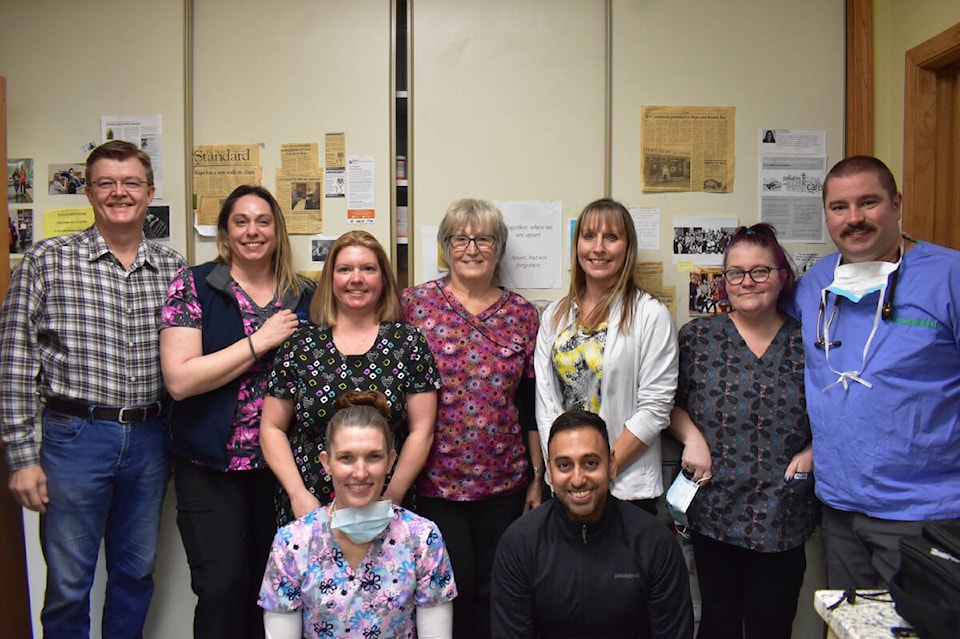Though the anniversary has past, the medical director of Fraser Canyon Hospital (FCH) says not enough recognition goes towards the Hope Medical Centre (HMC) staff for their hardwork during the historic flood of November 2021.
Dr. Aseem Grover has been a consistent face in the news lately. A rural addiction provider and rural family practitioner for Hope, Grover is being re-heralded for his heroic work during the floods and in the community. This includes, along with the efforts of other doctors, reaching a critically injured patient in Hope and getting him airlifted to B.C.’s Children’s Hospital where he received lifesaving surgery.
It was during this time, that the FCH — who, like many places in Hope, had lost power and were relying on a generator — found themselves in overdrive to ensure the safety and care of both their patients and everyone stranded in Hope.
Yet, Grover says none of what the doctors did would have been possible without the HMC staff, who were the “backbone” of the FCH.
“Without them, we would be totally out to lunch. I can’t think of an analogy to explain it better,” says Grover. “You just have to remember we have a lot of staff at that clinic and they literally bent over backwards to make sure no one was harmed or hurt. They literally provided all day and all night health services, not just working hours. They were readily available providing health services there… they’re not just healthcare providers, they’re also there as community support. And that’s very important.”
According to Grover, the HCM is responsible for 70 per cent of medical issues and concerns in the community. During the floods, he says that the hospital would have fallen apart without the HCM providing communication, virtual care support, phone call support, and ground support — all which allowed the FCH to serve the community.
“The most important thing people have to recognize is how important the Hope Medical Centre is,” says Grover. “Most [Hope medical staff], I’d say about 90 per cent of us, work in the hospital and the clinic. So that allows us to have good transitional models so we can safely discharge a patient into the community.”
Grover says that, because of the hard work that the staff puts in on a daily basis, Hope’s medical teams are able to operate on a preventative community model — which is something that other rural communities are currently trying to implement after the floods.
READ MORE: A community in crisis that still took the time to help
Grover is also involved in emergency management for rural communities in B.C. — which has been a topic of concern after the floods of 2021.
The floods of 2021 devastated most of the Lower Mainland. Houses and cars were swept away, mudslides happened, and people were stranded after highways were cut off at all sides. In fact, it was one of the most expensive climate-induced disaster events that Canada had ever seen, with an estimated cost of $7 to $8 billion.
Grover says the floods highlighted a number of structural weaknesses and problems. It also revealed how under prepared the province was when it came to atmospheric events.
“There has to be not just a community plan, but also a regional plan too because a lot of the floods were amplified by the weak structure points that were already in place,” says Grover. “Now the government and the Ministry of Transport have to acknowledge that there are weak structure points and we have to do something about them. And they are doing that. They’re strengthening the highways and they’re working on building those things in an improved matter. But it’s more about preventing ‘service slides’ from happening again.”
Because of the chaos created by the floods, changes are currently being made to help Hope (and other communities) be better prepared for future disasters. The first of which is actually having an emergency plan in place.
“You have to understand, before this event, we haven’t had [an emergency] plan in place,” says Grover. “We’ve always had mudslides and rock-slides, but they’ve never taken out all four routes of access. There’s never been a magnitude of floods, or mudslides, that wiped out access to Highway 7 and Highway 1 at the same time. As well as the Coquihalla Highway and Highway 3. That’s huge. So, when we were notified of the floods, we just assumed that Highway 7 was accessible. But when both are out and both exits are affected, that’s a totally different problem altogether. And no one in the province could have predicted that.
“We learned really quickly on the fly on providing what was necessary to get us through these moments.”
According to Grover, part of this new plan includes ensuring that Hope’s five vulnerable populations aren’t forgotten during the chaos. These five populations are cancer patients, seniors, those with breathing problems, palliative patients, and those suffering with addiction.
It also includes having emergency supplies and equipment in place, ready to go, should another atmospheric event happen.
Finally, Grover says that part of the new plan includes collaborative effort between all bodies of power and emergency groups within Hope. This includes collaborative efforts between the District of Hope, the mayor, Hope Search and Rescue (SAR), etc.
“So, more collaborative team planning,” says Grover. “It’s not just a discussion in the back of our mind. It’s now real and we have to ask, ‘how are we better today than we are yesterday’?”
READ MORE: Hope’s Panago Pizza owner reflects on feeding stranded travellers
@KemoneMoodley
kemone.moodley@hopestandard.com
Like us on Facebook and follow us on Twitter.
